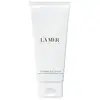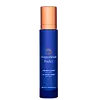What's inside
What's inside
 Key Ingredients
Key Ingredients

 Benefits
Benefits

 Concerns
Concerns

 Ingredients Side-by-side
Ingredients Side-by-side

Glycine Soja Oil
EmollientHydrogenated Polydecene
EmollientDimethicone
EmollientLimnanthes Alba Seed Oil
Skin ConditioningHelianthus Annuus Seed Oil
EmollientDextrin Palmitate
EmulsifyingTrisiloxane
Skin ConditioningOlea Europaea Fruit Oil
MaskingAlgae Extract
EmollientSesamum Indicum Seed Oil
EmollientMedicago Sativa Seed Powder
Skin ConditioningHelianthus Annuus Seedcake
AbrasivePrunus Amygdalus Dulcis Seed Meal
AbrasiveEucalyptus Globulus Leaf Oil
PerfumingSodium Gluconate
Skin ConditioningCopper Gluconate
Skin ConditioningCalcium Gluconate
HumectantMagnesium Gluconate
Skin ConditioningZinc Gluconate
Skin ConditioningTocopheryl Succinate
AntioxidantNiacin
SmoothingSesamum Indicum Seed Powder
Skin ConditioningWater
Skin ConditioningPrunus Amygdalus Dulcis Oil
Skin ConditioningBrassica Campestris Seed Oil
Skin ConditioningOxycoccus Palustris Seed Oil
AntioxidantPersea Gratissima Oil
Skin ConditioningCitrus Aurantifolia Peel Extract
CleansingRosmarinus Officinalis Leaf Extract
AntimicrobialTriticum Vulgare Germ Oil
EmollientVegetable Oil
Skin ConditioningPrunus Armeniaca Kernel Oil
MaskingHippophae Rhamnoides Oil
EmollientOenothera Biennis Oil
EmollientRosa Canina Fruit Oil
EmollientTocopherol
AntioxidantVitis Vinifera Seed Oil
EmollientCamelina Sativa Seed Oil
Skin ConditioningSimmondsia Chinensis Seed Oil
EmollientGlycerin
HumectantPolysorbate 80
EmulsifyingCaprylyl Glycol
EmollientCaprylic/Capric Triglyceride
MaskingSilica
AbrasiveParfum
MaskingBHT
AntioxidantLimonene
PerfumingLinalool
PerfumingBenzyl Benzoate
AntimicrobialCoumarin
PerfumingCitronellol
PerfumingGeraniol
PerfumingHydroxycitronellal
PerfumingCitral
PerfumingAlcohol Denat.
AntimicrobialGlycine Soja Oil, Hydrogenated Polydecene, Dimethicone, Limnanthes Alba Seed Oil, Helianthus Annuus Seed Oil, Dextrin Palmitate, Trisiloxane, Olea Europaea Fruit Oil, Algae Extract, Sesamum Indicum Seed Oil, Medicago Sativa Seed Powder, Helianthus Annuus Seedcake, Prunus Amygdalus Dulcis Seed Meal, Eucalyptus Globulus Leaf Oil, Sodium Gluconate, Copper Gluconate, Calcium Gluconate, Magnesium Gluconate, Zinc Gluconate, Tocopheryl Succinate, Niacin, Sesamum Indicum Seed Powder, Water, Prunus Amygdalus Dulcis Oil, Brassica Campestris Seed Oil, Oxycoccus Palustris Seed Oil, Persea Gratissima Oil, Citrus Aurantifolia Peel Extract, Rosmarinus Officinalis Leaf Extract, Triticum Vulgare Germ Oil, Vegetable Oil, Prunus Armeniaca Kernel Oil, Hippophae Rhamnoides Oil, Oenothera Biennis Oil, Rosa Canina Fruit Oil, Tocopherol, Vitis Vinifera Seed Oil, Camelina Sativa Seed Oil, Simmondsia Chinensis Seed Oil, Glycerin, Polysorbate 80, Caprylyl Glycol, Caprylic/Capric Triglyceride, Silica, Parfum, BHT, Limonene, Linalool, Benzyl Benzoate, Coumarin, Citronellol, Geraniol, Hydroxycitronellal, Citral, Alcohol Denat.
Water
Skin ConditioningCaprylic/Capric Triglyceride
MaskingGlyceryl Stearate
EmollientGlycerin
HumectantGlyceryl Stearate Citrate
EmollientDicaprylyl Ether
EmollientPanthenol
Skin ConditioningCetearyl Alcohol
EmollientXylitylglucoside
Humectant1,2-Hexanediol
Skin ConditioningButyrospermum Parkii Butter
Skin ConditioningSilica
AbrasiveAnhydroxylitol
HumectantHelianthus Annuus Seed Oil
EmollientXylitol
HumectantTocopheryl Acetate
AntioxidantXanthan Gum
EmulsifyingBisabolol
MaskingAlcohol
AntimicrobialGlucose
HumectantO-Cymen-5-Ol
AntimicrobialBiosaccharide Gum-2
Skin ConditioningChamomilla Recutita Flower Extract
MaskingCholesterol
EmollientHydrogenated Lecithin
EmulsifyingSodium Hydroxide
BufferingTocopherol
AntioxidantAlanyl Glutamine
HumectantAloe Barbadensis Leaf Juice Powder
Skin ConditioningArginine
MaskingCeramide Ng
Skin ConditioningCeramide NP
Skin ConditioningGlycine
BufferingLysine
Skin ConditioningOleic Acid
EmollientPalmitic Acid
EmollientPhenylalanine
MaskingProline
Skin ConditioningScenedesmus Rubescens Extract
Skin ConditioningBetula Alba Oil
MaskingDisodium EDTA
Oligopeptide-177
Phenoxyethanol
PreservativeSodium Ascorbate
AntioxidantWater, Caprylic/Capric Triglyceride, Glyceryl Stearate, Glycerin, Glyceryl Stearate Citrate, Dicaprylyl Ether, Panthenol, Cetearyl Alcohol, Xylitylglucoside, 1,2-Hexanediol, Butyrospermum Parkii Butter, Silica, Anhydroxylitol, Helianthus Annuus Seed Oil, Xylitol, Tocopheryl Acetate, Xanthan Gum, Bisabolol, Alcohol, Glucose, O-Cymen-5-Ol, Biosaccharide Gum-2, Chamomilla Recutita Flower Extract, Cholesterol, Hydrogenated Lecithin, Sodium Hydroxide, Tocopherol, Alanyl Glutamine, Aloe Barbadensis Leaf Juice Powder, Arginine, Ceramide Ng, Ceramide NP, Glycine, Lysine, Oleic Acid, Palmitic Acid, Phenylalanine, Proline, Scenedesmus Rubescens Extract, Betula Alba Oil, Disodium EDTA, Oligopeptide-177, Phenoxyethanol, Sodium Ascorbate
Ingredients Explained
These ingredients are found in both products.
Ingredients higher up in an ingredient list are typically present in a larger amount.
This ingredient is an emollient, solvent, and texture enhancer. It is considered a skin-softener by helping the skin prevent moisture loss.
It helps thicken a product's formula and makes it easier to spread by dissolving clumping compounds.
Caprylic Triglyceride is made by combining glycerin with coconut oil, forming a clear liquid.
While there is an assumption Caprylic Triglyceride can clog pores due to it being derived from coconut oil, there is no research supporting this.
Learn more about Caprylic/Capric TriglycerideGlycerin is already naturally found in your skin. It helps moisturize and protect your skin.
A study from 2016 found glycerin to be more effective as a humectant than AHAs and hyaluronic acid.
As a humectant, it helps the skin stay hydrated by pulling moisture to your skin. The low molecular weight of glycerin allows it to pull moisture into the deeper layers of your skin.
Hydrated skin improves your skin barrier; Your skin barrier helps protect against irritants and bacteria.
Glycerin has also been found to have antimicrobial and antiviral properties. Due to these properties, glycerin is often used in wound and burn treatments.
In cosmetics, glycerin is usually derived from plants such as soybean or palm. However, it can also be sourced from animals, such as tallow or animal fat.
This ingredient is organic, colorless, odorless, and non-toxic.
Glycerin is the name for this ingredient in American English. British English uses Glycerol/Glycerine.
Learn more about GlycerinHelianthus Annuus Seed Oil is the oil derived from the seeds of a Sunflower. Sunflower seed oil is non-fragrant. It is an emollient, meaning it helps to soften the skin.
Sunflower seed oil contains many fatty acids. The fatty acids found in sunflower seeds include (from highest amount to least): linoleic acid, myristic acid, palmitic acid, stearic acid, arachidic acid, oleic acid, and linolenic acid.
These fatty acids help the skin create ceramides. Ceramides play a role in repairing the skin barrier.
Helianthus Annuus Seed Oil helps moisturize the skin. This in turn helps the skin look more rejuvenated and smoother.
Sunflowers are rich in vitamin E.
Historians believe Indigenous cultures of North America domesticated sunflowers before corn. Thus they relied on sunflower oil for a variety of uses. One such use is moisturizing skin and hair.
Sunflower seed oil may not be fungal acne safe. We recommend speaking with a professional if you have any concerns.
Learn more about Helianthus Annuus Seed OilSilica, also known as silicon dioxide, is a naturally occurring mineral. It is used as a fine, spherical, and porous powder in cosmetics.
Though it has exfoliant properties, the function of silica varies depending on the product.
The unique structure of silica enhances the spreadability and adds smoothness, making it a great texture enhancer.
It is also used as an active carrier, emulsifier, and mattifier due to its ability to absorb excess oil.
In some products, tiny microneedles called spicules are made from silica or hydrolyzed sponge. When you rub them in, they lightly polish away dead skin layers and enhance the penetration of active ingredients.
Learn more about SilicaTocopherol (also known as Vitamin E) is a common antioxidant used to help protect the skin from free-radicals and strengthen the skin barrier. It's also fat soluble - this means our skin is great at absorbing it.
Vitamin E also helps keep your natural skin lipids healthy. Your lipid skin barrier naturally consists of lipids, ceramides, and fatty acids. Vitamin E offers extra protection for your skin’s lipid barrier, keeping your skin healthy and nourished.
Another benefit is a bit of UV protection. Vitamin E helps reduce the damage caused by UVB rays. (It should not replace your sunscreen). Combining it with Vitamin C can decrease sunburned cells and hyperpigmentation after UV exposure.
You might have noticed Vitamin E + C often paired together. This is because it is great at stabilizing Vitamin C. Using the two together helps increase the effectiveness of both ingredients.
There are often claims that Vitamin E can reduce/prevent scarring, but these claims haven't been confirmed by scientific research.
Learn more about TocopherolWater. It's the most common cosmetic ingredient of all. You'll usually see it at the top of ingredient lists, meaning that it makes up the largest part of the product.
So why is it so popular? Water most often acts as a solvent - this means that it helps dissolve other ingredients into the formulation.
You'll also recognize water as that liquid we all need to stay alive. If you see this, drink a glass of water. Stay hydrated!
Learn more about Water